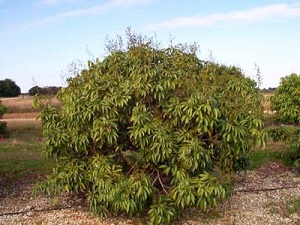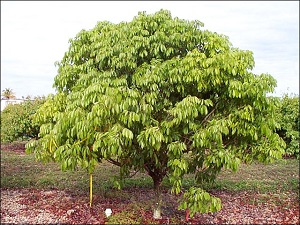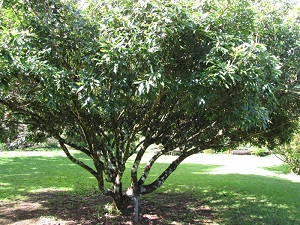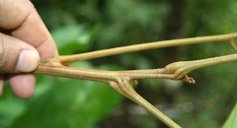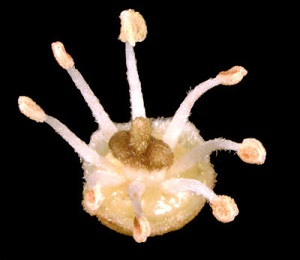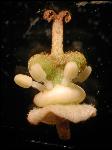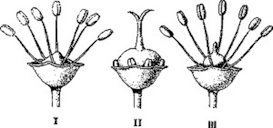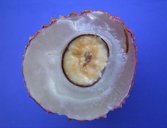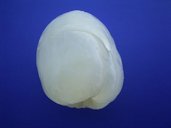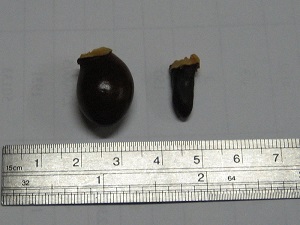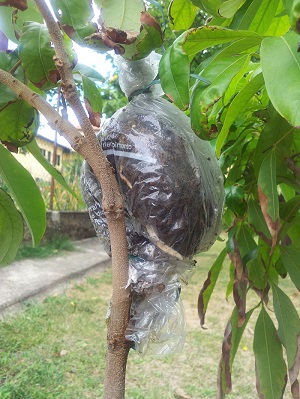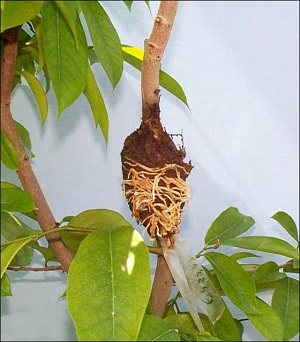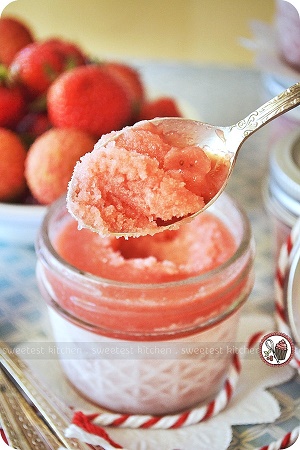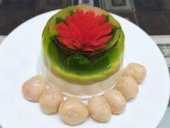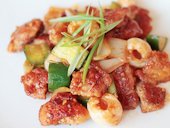| Lychee - Litchi chinensis | |||||||||||||||||||||||||||||||||||||||||||||||||||||||||||
|---|---|---|---|---|---|---|---|---|---|---|---|---|---|---|---|---|---|---|---|---|---|---|---|---|---|---|---|---|---|---|---|---|---|---|---|---|---|---|---|---|---|---|---|---|---|---|---|---|---|---|---|---|---|---|---|---|---|---|---|
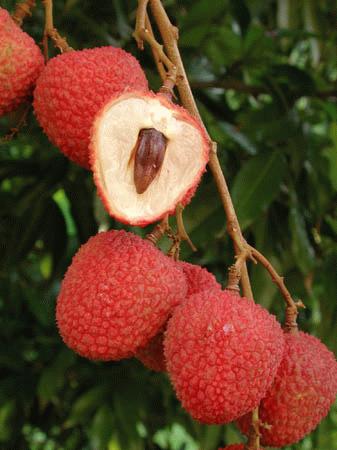 Fig. 1 Litchi chinensis Sonn. Sweetheart™ lychee 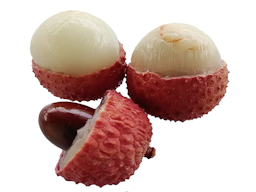 Fig. 2  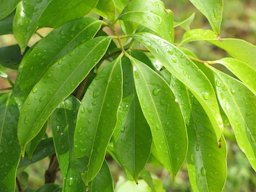 Fig. 3  L. chinensis (Litchi, lychee). Leaves at Garden of Eden Keanae, Maui, Hawai'i.  Fig. 4  Upper and lower surfaces of the compound lychee leaf 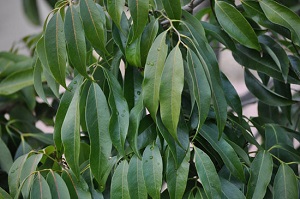 Fig. 5   Fig. 10 Lychee flowers are pollinated by bees and wind 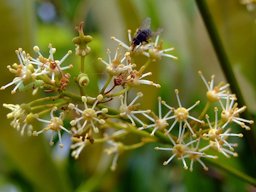 Fig. 11  Lychee (the fruit) is familiar to many people but not so many know what lychee flowers look like. Hong Kong Wetland Park. 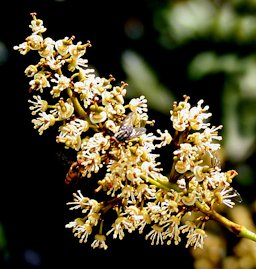 Fig. 12  Lychee L. chinensis at Samsing in Darjeeling district of West Bengal, India. 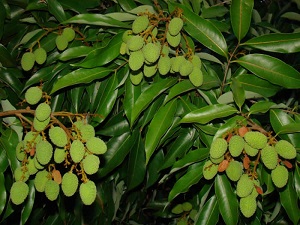 Fig. 16  Leaves and unripe fruit 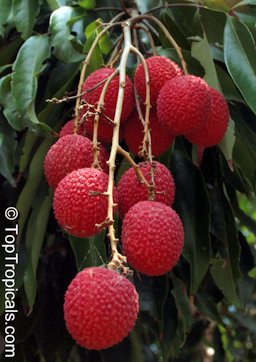 Fig. 17  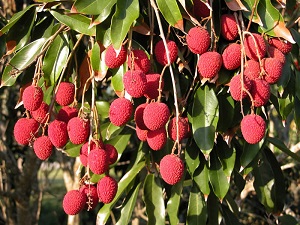 Fig. 24  Fruiting branches 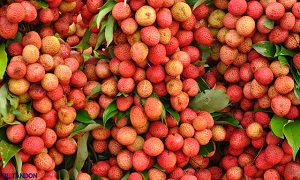 Fig. 25  Litchi, L. chinensis Sonn 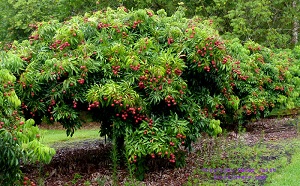 Fig. 26  Mature tree with ripe fruit 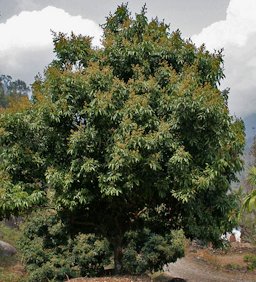 Fig. 27  Lychee L. chinensis at Samsing in Darjeeling district of West Bengal, India  Fig. 28  Trunks of L. chinensis (picture taken on Réunion island) 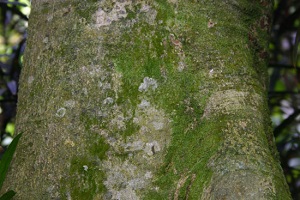 Fig. 29  Trunk 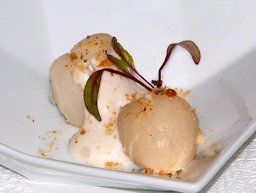 Fig. 30  Stuffed lychee 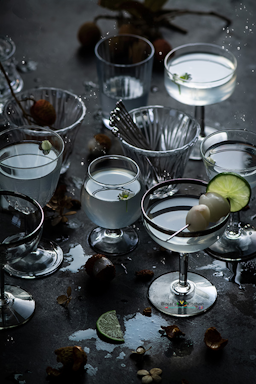 Fig. 31  Lychee lemonade with coconut water 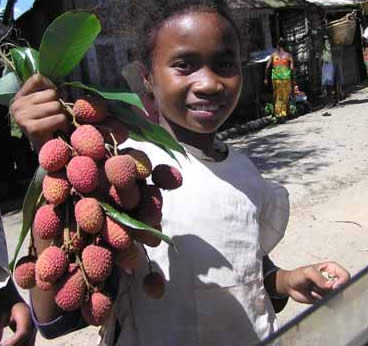 Fig. 36 In Madagascar  Fig. 37  Lychees for sale at a Malaysian fruit stall Fig. 38  L. chinensis being sorted on June 10, 2014 right after harvest in a small village several kilometres southwest of Haikou, Hainan, China. 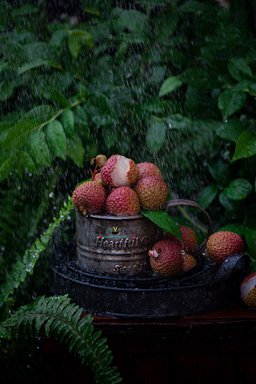 Fig. 39 Fig. 40  Lai Chi Kok Park, Hong Kong |
Scientific
name Litchi chinensis Sonn. Pronunciation LEE-chee chih-NEN-sis Common names Widely known as litchi and regionally as lichi, lichee, laichi, leechee or lychee; Spanish and Portuguese-speaking people call the fruit lechia; the French, litchi, or, in French-speaking Haiti, quenepe chinois, distinguishing it from the quenepe, genip or mamoncillo of the West Indies, Melicoccus bijugatus, q.v. The German word is Litschi. 5 Synonyms Corvinia litschi Stadtm. ex Willemet; Euphoria didyma Blanco; E. sinensis J.F.Gmel.; L. chinensis var. euspontanea H.H.Hsue; Nephelium chinense (Sonn.) Druce; N. didymum Craib, Unresolved; N. dimocarpus Hiern, Unresolved; N. duriocarpum T.Anderson ex Hiern, Unresolved; N. litchi Steud.; N. litchi Cambess.; Scytalia chinensis Gaertn.; Scytalia litschi Roxb.; Scytalia squamosa Stokes 8 Relatives Spanish lime, mamoncillo, kinep: Melicoccus bijugatus; longan, Dimocarpus longan Lour.; akee, Blighia sapida Koenig.; rambutan, Nephelium lappaceum L. 1 Family Sapindaceae (soapberry family) Origin Southern China and southeastern Asia USDA hardiness zones 10a-11 Uses Hedge; fruit; specimen; screen; container or planter; deck or patio Height 20-30 ft (6-10 m) Spread 20-30 ft (6-9 m) Plant habit Beautiful, dense, rounded; symmetrical canopy extending nearly to the ground (Fig. 6,27) Growth rate Slow/moderate Longevity 40-100 years Trunk/bark/branches Droop as the tree grows; typically multi-trunked Pruning requirement Young trees do not require pruning; later, the tree should be maintained at 10-15 ff (3.0-4.6 m) for ease of harvest Leaves Evergreen; compound with 2-8 leaflets; reddish when young, bright green as they mature Flower Small, yellow, and are borne on a large thyrse Fruit Drupe; loose clusters 3-50 fruits; round/oval; pulp whitish, translucent; glossy brown seed: freezes well Season Mid-May to early July in Florida, depending upon variety USDA Nutrient Content raw, dry pdf Light requirement Sun Soil tolerances Clay; loam; sand; slightly alkaline; acidic; occasionally wet; well-drained pH preference 5.5.-7.0 Drought tolerance Moderate Flood tolerance Occasionally wet Aerosol salt tolerance None Soil salt tolerance Poor Cold tolerance 24-28 °F (-4.4-2.2 °C) Plant spacing 35 ft (10.7 m) Roots Surface roots are usually not a problem Invasive potential * Considered not a problem species and may be used in Florida Pest/disease resistance Susceptible to scales and mushroom root rot can be a problem on soils where oaks were grown Known hazard None known Reading Material Lychee Growing in the Home Landscape, University of Florida pdf Litchi chinensis: Lychee, University of Florida pdf Litchi chinensis Sonn., PROSEA Foundation Litchi chinensis Sonn., Agroforestree Database Lychee, Fruits of Warm Climates Lychee, California Rare Fruit Growers Lychee, Litchi chinensis, Fairchild Tropical Botanic Garden Virtual Herbarium Lychee from Florida, University of Florida pdf Origin The lychee (Litchi chinensis) is the sole member of the genus Litchi in the soapberry family, Sapindaceae. It is a tropical and subtropical fruit tree native to the Guangdong and Fujian provinces of China, and now cultivated in many parts of the world. China is the main producer of lychees, followed by India, with production occurring among other countries in Southeast Asia, the Indian subcontinent and South Africa. 5 Lychee, its Origin, Distribution and Production Around the World, Archives of the Rare Fruit Council of Australia Origin of Lychees, Lychees Online Sapindaceous Fruits and Nuts, West Australian Nut and Tree Crop Association Description Lychee is a long-lived, evergreen tree that produces its new leaves, flowers and fruit on terminal shoots. The inflorescences produce many hundreds of functionally male and female flowers that carry from 5 to 80 attractive fruit at harvest. The red-skinned fruit contain a single seed, surrounded by a juicy sweet aromatic aril or flesh. Cultivars with large fruit, small seeds and a distinctive flavour are sought after in the market-place. 6
Leaves/Branches Leaves that bear two to eight pairs of leaflets. Lychee leaves are reddish upon initial flush, but become shiny and green as they mature.
Fig. 9. Petiole Flowers The flowers are small, yellowish-white, functionally male or female and apetalous. Functionally male flowers have six to ten stamens. There are usually two stages of male flowering overlapping with the female cycle: a true male flower first and then a functionally male flower that opens towards the end of the flowering period. The second male flower has a rudimentary bicarpellate pistil. This is absent in the first stage. Functionally female flowers have six to ten staminodes and a functional, bicarpellate pistil (Fig. 15). The last stage of male flowering generally supplies most of the pollen used to fertilize the female flowers. 6 The flowers grow in large, many-branched terminal clusters up to 75 cm (30 in) long. 9
Fig. 13. Male flower Fig. 14. Female flower
Flowering in Lychee Trees, Lychee Online How I make my Lychees Flower and Fruit Every Year, Archives of the Rare Fruit Council of Australia Irregular Flowering in Lychees, Archives of the Rare Fruit Council of Australia Fruit The fruit is a drupe and fruit are borne in loose clusters numbering from 3 to 50 fruits and are round to oval and 1.0 to 1.5 inches (25 to 38 mm) in diameter. The skin (pericarp) ranges from yellow to pinkish or red and is leathery, with small, short, conical or rounded protuberances. When fruits dry out (which happens just a few days after ripening), the skin becomes hard and brittle, with a nut-like firmness. The edible portion of the fruit (pulp) is called an aril that is succulent, whitish, translucent, with excellent subacid flavor. Fruits contain one shiny, dark brown seed, usually relatively large, but it may be small and shriveled (called chicken tongues) in some varieties. Fruit must be ripened on the tree for best flavor. 2,9
Fig. 20. A normal-sized seed (left) and a small-sized (chicken tongue) seed (right) Tips on Getting Your Lychee Tree to Produce Fruit, Lychees Online 5 Easy Steps for Girdling a Tree to Make it Produce More Fruit, Lychees Online Fruit Crack on Lychees, Archives of the Rare Fruit Council of Australia A Maturity Standard for Lychee, Archives of the Rare Fruit Council of Australia Varieties Page 'Brewster', 'Mauritius', 'Hak ip'
Harvesting The fruit must be allowed to ripen fully on the tree. Overly mature fruit darken in color and lose their luster. The flavor lacks the richness associated with a certain amount of acidity. To harvest, snip off entire fruit clusters, keeping a short piece of the stem attached. Lychees can be stored for up five weeks in the refrigerator. They can also be frozen or dried. Lychees will begin to deteriorate within three days at room temperature. 4 In China, great quantities of honey are harvested from hives near lychee trees. Honey from bee colonies in lychee groves in Florida is light amber, of the highest quality, with a rich, delicious flavor like that of the juice which leaks when the fruit is peeled, and the honey does not granulate. 5 Heaviest production is in June, with a lighter supply in mid May and early July. 7
Lychee Fruit Bagging for Commercial and Home Growers, University of Hawai'i at Mānoa pdf Lychee: Postharvest Quality-Maintenance Guidelines, University of Hawai'i at Mānoa pdf Pollination There are 3 types of flowers appearing in irregular sequence or, at times, simultaneously, in the lychee inflorescence: a) male; b) hermaphrodite, fruiting as female (about 30% of the total); c) hermaphrodite fruiting as male. The latter tend to possess the most viable pollen. Many of the flowers have defective pollen and this fact probably is the main cause of the abortive seeds and also the common problem of shedding of young fruits. The flowers require transfer of pollen by insects. 5 Propagation Lychee trees do not come true from seed, and seedling trees may take 10 or more years to bear fruit. Air layering is the most common method of propagation in Florida. In general, the larger the limb, the easier it is to air layer. Grafting (usually cleft or veneer) and budding onto lychee seedlings or air layers is possible but is not as common as air layering alone; this may change as superior rootstocks are identified. Top working is possible although not common and may become more common as superior cultivars are recommended. Air-layered or grafted trees begin to bear fruit in 3 to 5 years. 2 The Chinese method of air-layering has many variations. In fact, 92 modifications have been recorded and experimented with in Hawaii. Inarching is also an ancient custom, selected cultivars being joined to 'Mountain' lychee rootstock. In order to make air-layering less labor-intensive, to eliminate the watering, and also to produce portable, shippable layers, Colonel Grove, after much experimentation, developed the technique of packing the girdle with wet sphagnum moss and soil, wrapping it in moisture-proof clear plastic that permits exchange of air and gasses, and tightly securing it above and below. In about 6 weeks, sufficient roots are formed to permit detaching of the layer, removal of the plastic wrap, and planting in soil in nursery containers. It is possible to air-layer branches up to 4 in (10 cm) thick, and to take 200 to 300 layers from a large tree. 5
Fig. 21. Lychee (L. chinensis). "The fresh seed germinated in about 2 weeks. It has an aggressive root structure." Fig. 22. Propagating the plant by air layering - the young white roots are already showing in the plastic bag. Fig. 23. Air layering on a lychee tree
Air Layering Lychee Trees, Lychees Online Grafting and Grafted Lychee Trees, Lychees Online An Update on Graftage Methods for Lychee, Florida State Horticultural Society pdf Types of Propagation, Edible South Florida Top-Working Lychees - The Result 1995, Archives of the Rare Fruit Council of Australia Culture Lychee does not fruit satisfactorily at sea level in tropical climates and is best adapted to warm to cool subtropical areas. The best climates for lychee production have a dry, cold (but nonfreezing) winter period lasting 3 to 5 months; a warm spring during the flowering period; a hot and humid summer during fruit growth, development, and maturation; and moderately warm temperatures during the fall. Periodic rainfall during spring and summer is ideal. Young trees are damaged at temperatures of 28° to 32°F (-2° to 0°C), while temperatures down to 24° to 25°F (-3° to -4°C) cause extensive damage or death to large trees if exposed for several hours. Lychee trees do not acclimate to cold temperatures after exposure to cool, nonfreezing temperatures. Symptoms of cold damage include leaf death, leaf drop, stem and limb dieback, bark splitting, and tree death. 2
Steps for Planting a Landscape Lychee Tree in Your Yard, Lychees Online 8 Essential Factors for Growing Healthy Lychee Trees, Lychees Online Lychee Tree Root System and Development, Lychees Online Pruning Generally training of young trees is not required. However, formative pruning during the first 2 years may be desirable to encourage lateral branching and growth. After several years of production it is desirable to cut back the tops of the trees to 10 to 15 feet (3.0 to 4.6 m). Selectively removing a few upper limbs back to their origin (crotches) each year will help prevent the loss of the lower tree canopy due to shading by the upper canopy. Pruning should be carried out immediately after harvest to allow regrowth and maturation of new shoots and leaves before the onset of cool/cold winter temperatures. 2
Fertilizing Young trees (less than 4 years old) should be fertilized with 0.25 to 0.50 lbs (0.11 to 0.22 kg) of a complete fertilizer every 8 weeks. Fertilizer mixtures containing 6 to 8% nitrogen, 2 to 4% available phosphorus, 6 to 8% potash, and 3 to 4% magnesium are satisfactory. Twenty to 50% of the nitrogen should be in organic form. Once trees are 4 or more years old and begin fruit production, applications of nitrogen containing fertilizer from August until early spring (February–March) should be avoided. Nitrogen applications during this time may stimulate new vegetative growth (i.e., leaves and shoots) and reduce or eliminated the potential for flowering and fruit production. 2
Irrigation In the home landscape, trees will perform well without supplemental irrigation after trees are established. For more consistent cropping of mature trees, withholding irrigation during the fall and winter until bloom may enhance the amount of flowering. Watering during fruit set through harvest may enhance fruit quality and yields. 2
Wind Young lychee trees are sometimes difficult to establish in windy sites, and exposure to constant winds may result in tattered leaves, stunted shoot growth, and stem dieback. In the rocky soils of Miami-Dade County, the bark at the soil line of young trees may be damaged by continuous rubbing due to the movement caused by high winds. If possible, trees should be planted in wind-protected sites or protected from wind by surrounding trees with light shade cloth which has been attached to wire fencing. 2 Pest Page Pest Alert, Florida Department of Agriculture and Consumer Services pdf New Serious Pest of Lychee and Longan Trees Found in Florida: The Lychee Erinose Mite (LEM), Aceria litchii Lychee pests are very specific to the locale of the tree. In our grove in South Florida we get weevils, webworms and fungus. While there are lots of noxious life forms to be found on the trees such as ants, scale, lichens and stink bugs the big troublemakers are aforementioned nasties. Weevils and various types of beetles seem to cause the most damage to new leave growth, especially before the new growth has hardened off. These pests generally will not kill a tree although the weevils can severely retard the growth of a young tree by eating or damaging much of the new growth, thereby slowing development. The larval form of the weevils will eat the exterior covering of the roots and if they are in sufficient quantity can kill the tree. 1 Disease Page Food Uses Lychees are most relished fresh, out-of-hand. Peeled and pitted, they are commonly added to fruit cups and fruit salads. To a small extent, lychees are also spiced or pickled, or made into sauce, preserves or wine. Whole frozen lychees are thawed in tepid water. They must be consumed very soon, as they discolor and spoil quickly. 5
Fig. 32. Strawberry lychee sorbet Fig. 33. 3D jelly flowers with lychees Fig. 34. Sweet and sour chicken with lychees Fig. 35. Vegan mango cinnamon and caramelized lychee cupcake Lychee recipes, Taste Florida's Tropics Lychee Recipes, Virtual Herbarium at Fairchild Tropical Botanic Garden 5 Tips for Making a Good Lychee Martini, Lychees Online Dried Litchis, Archives of the Rare Fruit Council of Australia Florida Food Fare, University of Florida pdf (archived) Medicinal Properties ** Ingested in moderate amounts, the lychee is said to relieve coughing and to have a beneficial effect on gastralgia, tumors and enlargements of the glands. One stomach-ulcer patient in Florida, has reported that, after eating several fresh lychees he was able to enjoy a large meal that, ordinarily, would have caused great discomfort. In China, the seeds are credited with an analgesic action and they are given in neuralgia and orchitis. A tea of the fruit peel is taken to overcome smallpox eruptions and diarrhea. In India, the seeds are powdered and, because of their astringency, administered in intestinal troubles, and they have the reputation there, as in China, of relieving neuralgic pains. Decoctions of the root, bark and flowers are gargled to alleviate ailments of the throat. Lychee roots have shown activity against one type of tumor in experimental animals in the United States Department of Agriculture/National Cancer Institute Cancer Chemotherapy Screening Program. 5 Other Uses Apiculture: This tree is widely grown for instance in Singapore and Mauritius as a major honey source. Honey is harvested from hives that feed on lychee flowers and is prized for its lychee-like flavor and non-granulating texture. 9,11 The timber is said to be nearly indestructible. 10 Tannin or dyestuff: Bark contains tannin. 11 Ornamental: L. chinensis trees are beautiful in spring, when they are covered with huge sprays of flowers; they are also an attractive sight when in full fruit. These characteristics make it a popular ornamental tree in parks and gardens. 11 Alcohol: Lychee fruit can be processed into wine. 11 General Because of the firmness of the shell of the dried fruits, they came to be nicknamed "lychee, or litchi, nuts" by the uninitiated and this erroneous name has led to much misunderstanding of the nature of this highly desirable fruit. It is definitely not a "nut", and the seed is inedible. 5 The specific name, ‘chinensis’, is Latin for ‘Chinese’. 11 Further Reading Loving Lychee, Manatee County Master Gardener Newsletter Growing Lychees in Hawaii, University of Hawai'i at Mānoa pdf New Options for Lychees and Longans Fans and Farmers, USDA Agriculture Research Service Florida Growers Like Lychees and Longans, USDA Agriculture Research Service The Lychee Crop in Asia and the Pacific, Food and Agriculture Organization of the United Nations pdf The Litchi and its Relatives, Manual Of Tropical And Subtropical Fruits More on Lychees, Archives of the Rare Fruit Council of Australia Lychee Botanical Art List of Growers and Vendors |
||||||||||||||||||||||||||||||||||||||||||||||||||||||||||
| Bibliography 1 Folino, Krystal, and Bill Mee. "8 Essential Factors for Growing Healthy Lychee Trees." Lychees Online, lycheesonline.com. Accessed 24 Jan. 2014. 2 Crane, Jonathan H., et al. "Lychee Growing in the Florida Home Landscape." Horticultural Sciences Department, University of Florida, IFAS Extension, HS-6, Original Pub. Oct. 1968, Revised Feb. 1998, Feb. 2005, Oct. 2008, Oct. 2013 and Nov. 2016, Reviewed Dec. 2019, EDIS, edis.ifas.ufl.edu/mg051. Accessed 21 Feb. 2017, 9 May 2020. 3 Mee, William. "Grafting and Grafted Lychee Trees." Lychees Online, lycheesonline.com. Accessed 24 Jan. 2014. 4 "Lychee, Litchi chinensis Sonn." California Rare Fruit Growers,1996. crfg.org. Accessed 11 June 2014. 5 Fruits of Warm Climates. Julia F. Morton, Miami, 1987. 6 Menzer, Christopher. "The Lychee Crop in Asia and Pacific." Food and agriculture organization of the United Nations, Regional office for Asia and the Pacific, Bangkok, Thailand, 2002, FAO, fao.org. Accessed 15 Dec. 2016. 7 Crane, Jonathan H., et al. "Lychee from Florida." Horticultural Sciences Department, University of Florida, IFAS Extension, HS1106, Original Pub. July 2007, Revised Nov. 2016, Reviewed Dec. 2019, EDIS, edis.ifas.ufl.edu/hs144. Accessed 21 Feb. 2017, 9 May 2020. 8 "Synonyms for Litchi chinensis Sonn." The Plant List (2013), Version 1.1, www.theplantlist.org. Accessed 12 May 2020. 9 Courteau, Jacqueline. "Lychee, Litchi chinensis Sonner. Brief Summary." Encyclopedia of Life, EOL, (CC BY-NC-SA 3.0), eol.org/pages/47126025/articles. Accessed 12 May 2020. 10 Menzel, C. M. "Licthi chinensis Sonn." Edible fruits and nuts, Plant Resources of South-East Asia No 2, Edited by Verheij, E.W.M. and Coronel, R. E., PROSEA Foundation, Bogor, Indonesia, record 1530,1991, PROSEA, (CC BY-NC-SA 3.0), www.prota4u.org/prosea/view.aspx?id=1515. Accessed 14 May 2020. 10 Orwa, C., et al. "Litchi chinensis Sonn." Agroforestree Database: a tree reference and selection guide, version 4.0, 2009, Agroforestry, www.worldagroforestry.org/treedb2/speciesprofile.php?Spid=1080. Accessed 14 May 2020. Videos v1,2,3,4,5,8,9,10,11,12,13 Crane, Johathan H., and Ian Maguire. "Cultural practices for the lychee." University of Florida, IFAS/TREC. v 6,7 Jaschinski, Peter. "Air layering of lychee trees." Palm Beach Chapter of The Rare Fruit Council International. Photographs Fig. 1 Mee, Bill, and Krystal Folino. "A cluster of Emperor Lychee Fruit." Lychees Online, lycheesonline.com. Accessed Cir. 2007. Fig. 2 Filo gèn'. "Lychees on white background." Wikimedia Commons, 26 June 2018, GFDL, (CC BY-SA 4.0), commons.wikimedia.org/wiki/File:Litchi_chinensis_on_White_background.jpg. Accessed 11 May 2020. Fig. 3 Starr, Forest, and Kim. "Litchi chinensis (Litchi, lychee). Leaves at Garden of Eden Keanae, Maui, Hawai'i." Wikimedia Commons, via Starr Environmental, no. 110330-3591, 30 Mar. 2011, (CC BY 3.0 US), commons.wikimedia.org/wiki/File:Starr-110330-3591-Litchi_chinensis-leaves-Garden_of_Eden_Keanae-Maui_(41315075202).jpg. Accessed 11 May 2020. Fig. 4,6,7,10,13,14,23 Maguire, Ian. UF/IFAS/TREC, edis.ifas.ufl.edu. Accessed 25 Jan. 2014. Fig. 5,29 Mark, W., and J. Reimer. "Lychee, Litchi chinensis." SelecTree, UFEI, selectree.calpoly.edu. Accessed 27 Mar. 2015. Fig. 8 Starr, Forest and Kim. "Litchi chinensis subsp. chinensis (Litchi, lychee) Habit. Garden of Eden Keanae, Maui." Starr Environmental, starrenvironmental.com. Accessed 30 Mar. 2015. Fig. 9 Janzen, Daniel H. "Stem." Guanacaste Dry Forest ConservationFund, 2010, EOL, (CC BY-NC-SA 3.0), eol.org/pages/47126025/media. Accessed 8 May 2020. Fig. 11 Kai Yan, and Joseph Wong. "Lychee (the fruit) is familiar to many people but not so many know how Lychee flowers look like. This is the first time I see Lychee flowers. This photo was captured in the Hong Kong Wetland Park." Encyclopedia of Life, 4481579000, EOL, (CC BY-NC-SA 2.0), eol.org/pages/47126025/media. Accessed 8 May 2020. Fig. 12 Garg, J. M. "Lychee Litchi chinensis at Samsing in Darjeeling district of West Bengal, India." Wikimedia Commons, GFDL, (CC BY-SA 3.0), commons.wikimedia.org/File:Lychee_(Litchi_chinensis)_at_Samsing,_Duars,_West_Bengal_W2_IMG_6504.jpg. Accessed 11 May 2020. Fig. 15 "The Lychee Crop in Asia and Pacific." Food and agriculture organiation of the United Nations, Regional office for Asia and the Pacific, Bangkok, Thailand, FAO, fao.org. Accessed 15 Dec. 2016. Fig. 16 Thaumaturgist. "Leaves and unripe fruits." Tropical Plants Database, tropical.theferns.info. Accessed 27 Mar. 2015. Fig. 17 "Litchi chinensis, Nephelium litchi." Top Tropicals, toptropicals.com. Accessed 15 Dec. 2016. Fig. 18 Antheunisse, Max. "Litchi chinensis." Plant Illustrations, Madagascar, plantillustrations.org/illustration.php?id_illustration=68848. Accessed 12 May 2020. Fig. 19 Antheunisse, Max. "Litchi chinensis." Plant Illustrations, Madagascar, plantillustrations.org/illustration.php?id_illustration=68851. Accessed 12 May 2020. Fig. 20 Thomas621. "A normal-sized seed (left) and a small-sized (Chicken tongue) seed (right)." Wikipedia, 2007, Public Domain, wikipedia.org. Accessed 22 Feb. 2017. Fig. 21 Whitinger, Dave. "Lychee (Litchi chinensis). "The fresh seed germinated in about 2 weeks. It has an agressive root structure." All Things Plants, 6 July 2007, Wikimedia Commons, GFDL, (CC BY-SA 3.0), commons.wikimedia.org/wiki/File:Lychee_(Litchi_chinensis).jpg. Accessed 8 May 2020. Fig. 22 Lorenzini, Lacopo. "Propagating the plant by air layering - the young white roots are already showing in the plastic bag." Tropical Plants Database, tropical.theferns.info. Accessed 27 Mar. 2015. Fig. 24 Thaumaturgist. "Fruiting branches."Tropical Plants Database, tropical.theferns.info. Accessed 27 Mar. 2015. Fig. 25 Tandon, Parshotam Lal. "Litchi, Litchi chinensis Sonn, Family: Spindaceae." Flickr, 2014, flickr.com. Accessed 27 Mar. 2015. Fig. 26 Jaitt, Oscar. "Lychee tree 'Kaimana'." Fruitlovers, fruitlovers.com. Accessed 14 Dec. 2016. Fig. 27 Garg, J. M. "Lychee Litchi chinensis at Samsing in Darjeeling district of West Bengal, India." Wikimedia Commons, 20 Mar. 2008, GFDL, (CC BY-SA 3.0), commons.wikimedia.org/File:Lychee_(Litchi_chinensis)_at_Samsing,_Duars,_West_Bengal_W2_IMG_6508.jpg. Accessed 11 May 2020. Fig. 28 navez, B. "Trunks of Litchi chinensis. Picture taken on Réunion island." Wikimedia Commons, 2006, (CC BY-SA 3.0), commons.wikimedia.org. Accessed 28 Mar. 2015. Fig. 30 "Stuffed Lychee." Foodista, 13 Feb. 2010, (CC BY 3.0), www.foodista.com/recipe/BDJRGPK6/stuffed-lychee. Accessed 8 May 2020. Fig. 31,39 "Lychee Lemonade with Coconut Water." Binjal's Veg Kitchen, 14 June 2021, (CC BY-NC-ND 4.0), binjalsvegkitchen.com/lychee-lemonade-with-coconut-water/. Accessed 21 June 2021. Fig. 32 jamieanne. "Strawberry Lychee Sorbet." Flickr, 2013, (CC BY-ND 2.0), flickr.com. Accessed 21 Feb. 2017. Fig. 33 Blackswan. "3D Jelly Flowers with Lychees." Foodista, 16 Feb. 2018, (CC BY 3.0), www.foodista.com/recipe/3V6JSNPH/3d-jelly-flowers-with-lychees. Accessed 8 May 2020. Fig. 34 Bing. "Sweet & Sour Chicken with Lychees." Foodista, 17 Oct. 2011, (CC BY 3.0), www.foodista.com/recipe/DYT75J32/sw. Accessed 8 May 2020. Fig. 35 "Vegan Mango Cinnamon and Caramelized Lychee Cupcake." Vegan Feast Catering, 3 July 2010, Wikimedia Commons, (CC BY 2.0), commons.wikimedia.org/wiki/File:Vegan_Mango_Cinnamon_and_Caramelized_Lychee_Cupcake_(4759671061).jpg. Accessed 8 May 2020. Fig. 36 Antheunisse, Max. "Litchi chinensis." Plant Illustrations, Madagascar, plantillustrations.org/illustration.php?id_illustration=68742. Accessed 12 May 2020. Fig. 37 Hardman, Emilie. "Lychees for sale at a Malaysian fruit stall." Flickr, 2007, (CC BY-NC-SA 2.0), flickr.com. Accessed 29 Mar. 2015. Fig. 38 Frodesiak, Anna. "Litchi chinensis being sorted on June 10, 2014 right after harvest in a small village several kilometres southwest of Haikou, Hainan, China." Wikimedia Commons, 9 June 2014, (CC 0 1.0), commons.wikimedia.org/wiki/File:Litchi_chinensis_sorting_-_01.JPG. Accessed 8 May 2020. Fig. 40 Hokachung. "Lai Chi Kok Park." Wikimedia Commons, 6 July 2009, (CC BY 3.0), commons.wikimedia.org/wiki/File:Lai_Chi_Kok_Park_(1).JPG. Accessed 8 May 2020. * UF/IFAS Assessment of Non-native Plants in Florida's Natural Areas ** Information provided is not intended to be used as a guide for treatment of medical conditions. Published 12 Oct. 2013 LR. Last update 1 Oct. 2021 LR |
|||||||||||||||||||||||||||||||||||||||||||||||||||||||||||
